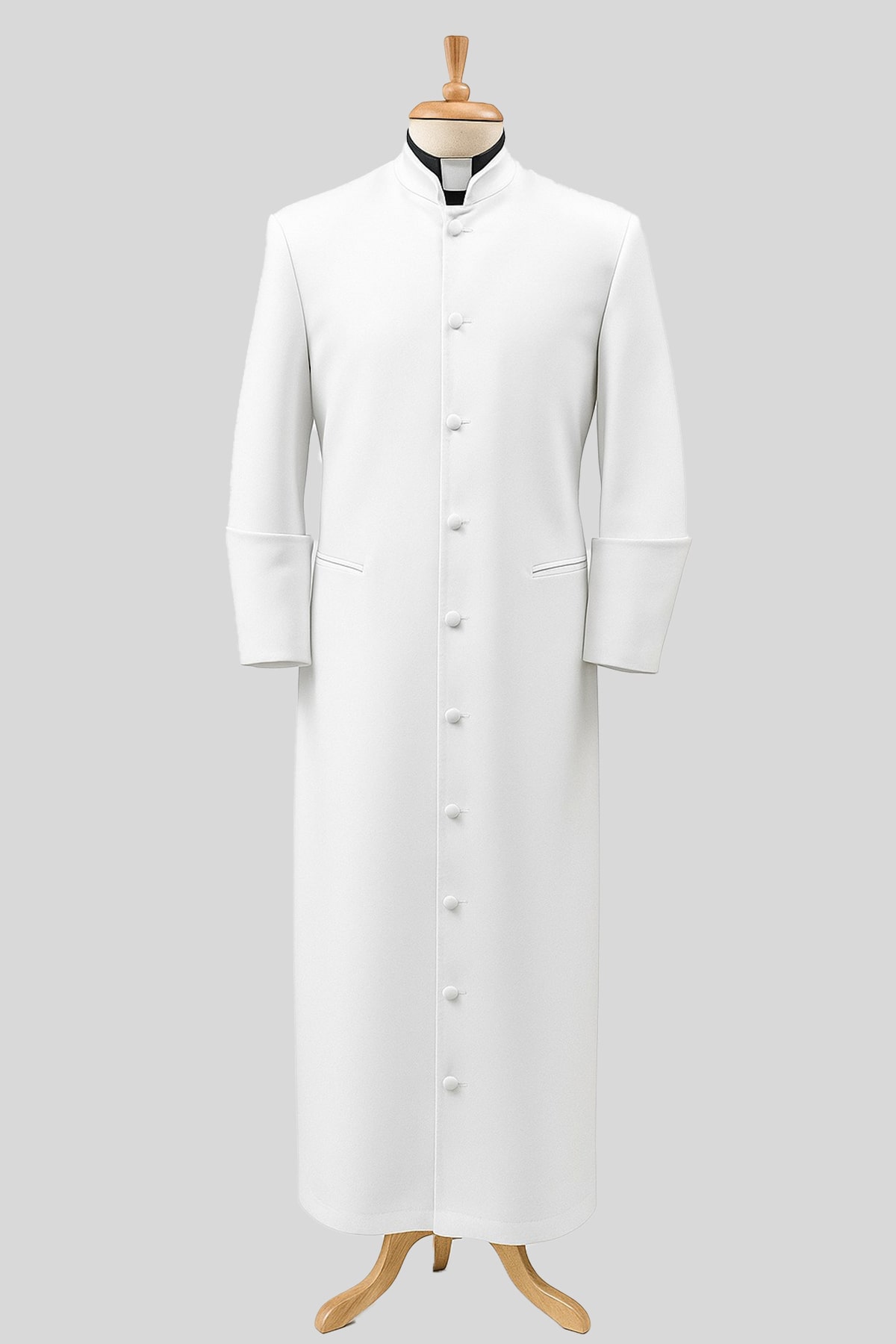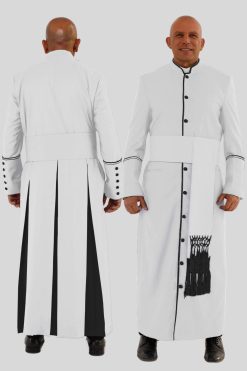No products in the cart.
Return To ShopHoly Clergy
Size Guide of Clergy Robes & Cassock for Men
Find Your Size
Enter your measurements below for personalized size recommendations.
Measurement Units:
Sizing Chart of Men's Clergy Robe & Cassock
| Size | Height | Length | Max Chest | Max Waist | Sleeve | Neck | Shoulder |
|---|---|---|---|---|---|---|---|
| 38 Short | 5'7" to 5'8" | 56" | 40" | 41" | 33" | 15" | 17½" |
| 38 Regular | 5'9" to 5'10" | 58" | 40" | 41" | 34" | 15" | 17½" |
| 38 Long | 5'11" to 6'0" | 60" | 40" | 41" | 35" | 15" | 17½" |
| 40 Short | 5'7" to 5'8" | 56" | 42" | 43" | 33" | 15½" | 18" |
| 40 Regular | 5'9" to 5'10" | 58" | 42" | 43" | 34" | 15½" | 18" |
| 40 Long | 5'11" to 6'0" | 60" | 42" | 43" | 35" | 15½" | 18" |
| 42 Short | 5'7" to 5'8" | 56" | 44" | 45" | 33" | 16" | 18½" |
| 42 Regular | 5'9" to 5'11" | 58" | 44" | 45" | 34" | 16" | 18½" |
| 42 Long | 6'0" to 6'1" | 60" | 44" | 45" | 35" | 16" | 18½" |
| 44 Short | 5'7" to 5'8" | 56" | 46" | 47" | 34" | 16½" | 19" |
| 44 Regular | 5'9" to 5'11" | 58" | 46" | 47" | 35" | 16½" | 19" |
| 44 Long | 6'0" to 6'1" | 60" | 46" | 47" | 36" | 16½" | 19" |
| 46 Short | 5'7" to 5'8" | 56" | 48" | 49" | 34" | 17" | 19½" |
| 46 Regular | 5'9" to 5'11" | 58" | 48" | 49" | 35" | 17" | 19½" |
| 46 Long | 6'0" to 6'1" | 60" | 48" | 49" | 36" | 17" | 19½" |
| 48 Short | 5'7" to 5'8" | 56" | 50" | 51" | 34" | 17½" | 20" |
| 48 Regular | 5'9" to 5'11" | 58" | 50" | 51" | 35" | 17½" | 20" |
| 48 Long | 6'0" to 6'1" | 60" | 50" | 51" | 36" | 17½" | 20" |
| 50 Short | 5'8" to 5'9" | 57" | 52" | 53" | 34" | 18" | 20½" |
| 50 Regular | 5'10" to 6'0" | 59" | 52" | 53" | 35" | 18" | 20½" |
| 50 Long | 6'1" to 6'2" | 61" | 52" | 53" | 36" | 18" | 20½" |
| 52 Short | 5'8" to 5'9" | 57" | 54" | 55" | 34" | 18½" | 21" |
| 52 Regular | 5'10" to 6'0" | 59" | 54" | 55" | 35" | 18½" | 21" |
| 52 Long | 6'1" to 6'2" | 61" | 54" | 55" | 36" | 18½" | 21" |
| 54 Short | 5'11" to 6'0" | 60" | 56" | 55" | 34" | 19" | 21½" |
| 54 Regular | 6'1" to 6'2" | 62" | 56" | 57" | 35" | 19" | 21½" |
| 54 Long | 6'3" to 6'5" | 64" | 56" | 57" | 36" | 19" | 21½" |
| 56 Short | 5'11" to 6'0" | 60" | 58" | 59" | 34" | 19½" | 22" |
| 56 Regular | 6'1" to 6'2" | 62" | 58" | 59" | 35" | 19½" | 22" |
| 56 Long | 6'3" to 6'5" | 64" | 58" | 59" | 36" | 19½" | 22" |
| 58 Short | 5'11" to 6'0" | 60" | 60" | 61" | 34" | 20" | 22½" |
| 58 Regular | 6'1" to 6'2" | 62" | 60" | 61" | 35" | 20" | 22½" |
| 58 Long | 6'3" to 6'5" | 64" | 60" | 61" | 36" | 20" | 22½" |
How to Measure for Your Clergy Robe & Cassock
Follow these step-by-step instructions to ensure the perfect fit for your clergy garments. Have someone assist you for the most accurate measurements.
Chest Measurement
Step 1: Wear a well-fitting shirt or undergarment
Step 2: Wrap the measuring tape around the fullest part of your chest
Step 3: Keep the tape parallel to the floor and snug but not tight
Step 4: Breathe normally and record the measurement
💡 Tip: This is the most important measurement for proper fit
Height Measurement
Step 1: Stand straight against a wall without shoes
Step 2: Keep your feet together and look straight ahead
Step 3: Have someone mark the top of your head on the wall
Step 4: Measure from the floor to the mark
💡 Tip: Determines the proper length (Short, Regular, or Long)
Waist Measurement
Step 1: Find your natural waistline (narrowest part of torso)
Step 2: Wrap the tape around your waist comfortably
Step 3: Don't suck in your stomach - breathe normally
Step 4: The tape should be snug but not constricting
💡 Tip: Usually located just above your hip bones
Sleeve Length
Step 1: Bend your arm slightly at the elbow
Step 2: Measure from the center back of your neck
Step 3: Go over the shoulder and down to your wrist bone
Step 4: The sleeve should end at your wrist bone
💡 Tip: Bend your arm for a more comfortable fit
Neck Measurement
Step 1: Wrap the tape around the base of your neck
Step 2: Keep one finger between the tape and your neck
Step 3: The tape should sit where a collar would rest
Step 4: Ensure you can breathe and swallow comfortably
💡 Tip: Add ½ inch for comfort if wearing a clerical collar
Shoulder Width
Step 1: Stand with arms relaxed at your sides
Step 2: Measure from the edge of one shoulder to the other
Step 3: Go across the back at the widest point
Step 4: Keep the tape straight and level
💡 Tip: This ensures proper drape and comfort














Wrong size received
They send me wrong product